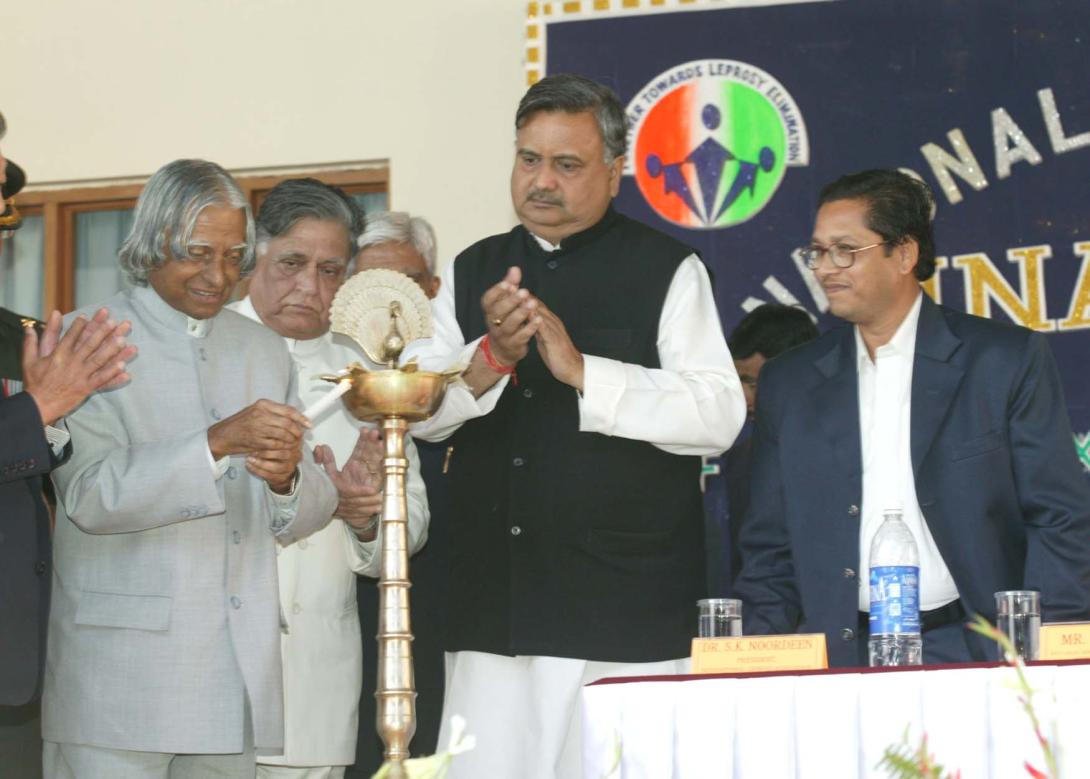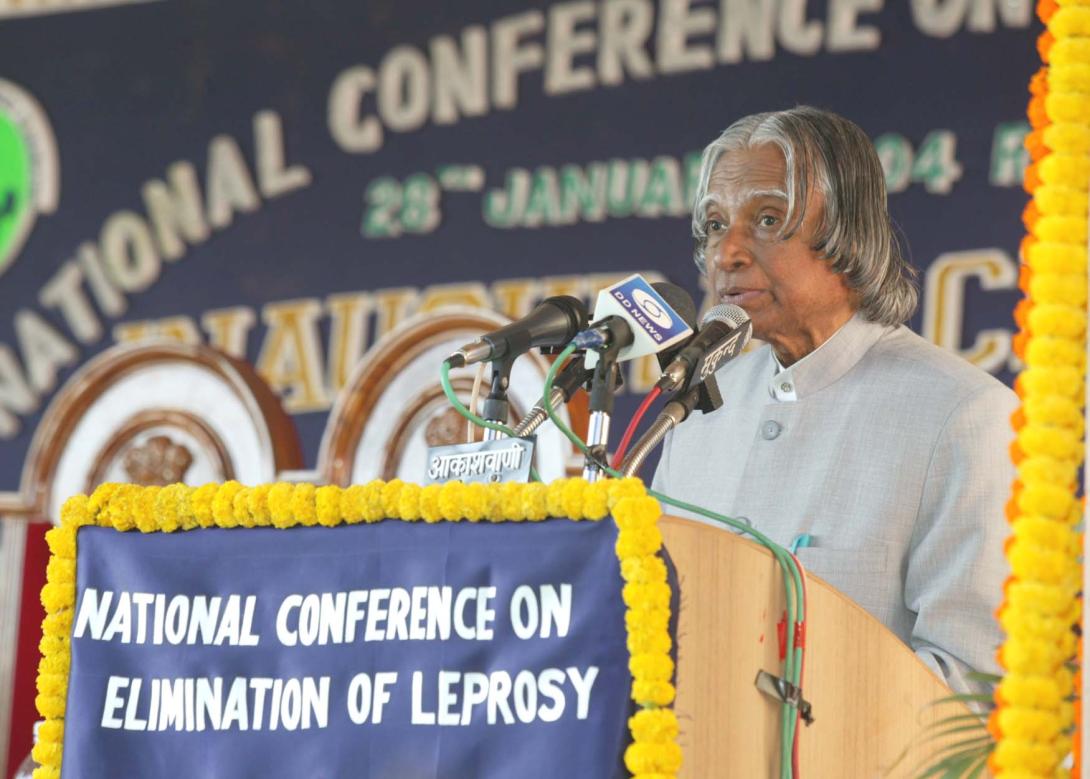Address at the National Conference on Elimination of Leprosy
Raipur : 28-01-2004
Rehabilitation with Compassion
I am delighted to participate in the National Conference on Elimination of Leprosy organized at the initiative of International Leprosy Organisation. I greet the organizers, participants, leprosy eradication and rehabilitation organisations and distinguished guests. I was thinking what I can talk to this enlightened audience. I have chosen the topic ?Rehabilitation with compassion?.
Status of Leprosy elimination in India
I am happy to note that the total number of patients has come down from 4 million to 0.3 million during the period 1981-2003. I congratulate the organizers of National Leprosy Elimination Project authorities for achieving this good result. However, I find the 70% of the total leprosy patients are concentrated in five major states Bihar, UP, West Bengal, Orissa and Chatisgarh. Concerted efforts are needed for diagnosing the causes for this situation and developing strategies by which we can bring down to the level of less than one leprosy case per ten thousand population by the year 2005. It is essential that this should be done positively and should not be further shifted. Also, there is a need to work out methods by which we will be in a position to rehabilitate the treated patients.
Gujarat model
I was studying the efforts made by Gujarat for leprosy elimination, disability care and rehabilitation of leprosy patients. They have carried out a comprehensive programme in which the state government medical colleges, hospitals and non-government organisations have become active partners. Based on the needs of particular districts they have carried out reconstructive surgery camps and mega camps to treat large number of patients. The micro planning for achieving the elimination integrated with the disability care enable targeted elimination of leprosy in Gujarat state.
Also number of NGOs have sponsored the treated leprosy patients for training them in handicrafts and cottage industries, so that they can find productive employment in their villages or they could find self employment opportunities towards rehabilitation. This model can be followed by many other states where the prevalence of leprosy cases is quite large.
Leprosy cases in India
I was studying the map of India and the leprosy distribution in the whole country. I noted that the north western region and extreme north east is virtually free from leprosy. As we proceed to the east there is a gradual increase and the concentration is in five states located in the central north eastern region. Specialists must analyse the causes for increased occurrence in these states to facilitate appropriate environmental remedial measures.
I was studying the case of a person who had turned a new leaf in his life. He was also presented with the President's Award for the ``Best Self-Employed Person". This being a great achievement in itself, his struggle was praise worthy as he has risen above ostracisation and the stigma of being a leprosy patient.
After 7 years of treatment in a Welfare and Rehabilitation Centre for Leprosy Patients, he is fully cured and runs his own telephone booth at a City Railway Station. This model should be followed by other rehabilitation centres in the country to make the treated leprosy patients feel normal to function in the society. All our NGOs should study such cases and provide treatment and rehabilitation with compassion. NGOs can make use of the rehabilitated patients to work on leather-craft, tailoring, printing, knitting and other units.
Permanent cure ? what is to be done?.
Early detection of the disease is essential in order to avoid permanent nerve damage and deformities. This will need survey of the population and detection. We need to educate the population about facts, the signs and cure for leprosy.
Multiple Drug Therapy (MDT) a combination of the anti-leprosy drugs such as rifampicin, clofazimine and dapsone has been found to be very effective treatment of the disease. This can be followed by government and non-government agencies working in treatment plans. Patients who have developed deformities/disabilities would need special care in providing suitable jobs which will ensure non-recurrence of the disease and also does not cause discomfort while working.
Programme Strategies
In endemic districts domiciliary treatment should be provided through staff trained in leprosy. For this purpose states who have successfully combated leprosy could help other states to follow their model. In moderate and low endemic districts treatment can be done through mobile leprosy clinics. We should organize health education to the patients, their families and the community to increase- awareness and to remove the stigma among the treated patients. This should become the essential part of rehabilitation. Deformity and ulcer care should become the part of the rehabilitation plan. NGO working in difficult area could make use of this strategy effectively for eradicating the leprosy in a time bound manner.
Regional development ? poverty and disease elimination
Real cure for elimination of leprosy lies in development of the region, that means developing the district, and the state. The development approach would provide for the people better amenities, clean drinking water, better hygiene and sanitation, better education and awareness, better healthcare, nutritious food resulting in livable environment. This holistic approach is the vital need for eliminating leprosy in endemic regions apart from the symptomatic cure being provided to existing cases. I would recommend the state governments in participation with non-governmental organisations to identify the endemic districts and initiate developmental measures. Providing Urban Amenities in Rural Areas (PURA) will be the ideal option for such districts.
Economic Connectivity for PURA
Providing Urban facilities in Rural Areas (PURA) consisting of four connectivities: physical, electronic, knowledge and there by leading to economic connectivity to enhance the prosperity of clusters of villages in the rural areas. The economic connectivity will generate a market and the production establishments for servicing the market. The PURA has all the dimensions to become a business enterprise. The PURA entrepreneur has to have the skill for evolving a business plan with banks and also create infrastructural support such as educational institutions, health centres and small scale industries, transportation services, tele-education, tele-medicine, e-governance services in the region integrating with the governmental rural development schemes such as road, communication and transport. Can the government in partnership with the Leprosy Eradication Programme Organisations create a PURA enterprise and entrepreneur with the required business and managerial skill?
Employment Generation through entrepreneurship
There has been substantial growth in our higher educational system and we are generating over 3 million graduates every year. However our employment generation system is not in a position to absorb the graduates passing out from the universities leading to increase in educated unemployed, year after year. This situation will lead to instability in the social structure. We need higher education backed by employment opportunities. A multi pronged strategy is needed to make education more attractive and simultaneously create employment potential ? how do we do that?
Firstly, the educational system should highlight the importance of entrepreneurship and prepare the students right from the college education to get oriented towards setting up of the smallscale industrial enterprises and any ventures in our rural areas which will provide them creativity, freedom and ability to generate wealth. Apart from entrepreneurship, the youth should have the spirit that ?we can do it?. Secondly, the banking system should provide venture capital right from every village level to the prospective entrepreneurs for undertaking new enterprises. Banks have to be proactive to support the innovative products for enabling wealth generation by young entrepreneurs by setting aside the ?conventional tangible asset syndrome?. Definitely this involves certain amount of calculated risks which can be eliminated by making an analysis of successful venture capital enterprises. Thirdly, there is a need to identify marketable products and enhancement of purchasing power among the people.
PURA Enterprise
The SSI sector has experience in managing the small scale industries of different types in various regions. This sector is widespread in the country and is a promising candidate for becoming the chief and managing the PURA complexes in an integrated way. PURA enterprises can undertake management of schools, health care units, with specifically suited to manage leprosy, vocational training centres, chilling plants, silos and building a market, banking system and the regional business or industrial units. A new management style has to emerge for managing such type of PURA enterprises. This new PURA enterprise needs partnership from the bank, from the Government and also from the private entrepreneurs.
Conclusion
The eradication of leprosy is a multi-dimensional task. It involves an integrated approach from NGOs, medical institutions, hospitals, rehabilitation institutions, development institutions, research institutions and small scale industrial units to eradicate the occurrence of the disease in a time bound manner. I would request the participants in the programme to work with the theme ?Let my brain remove the pain? of the suffering community. Concerted action is required by the Central Government, State Government and all the agencies working on leprosy eradication so that the country is free from this disease within a prescribed time frame.


